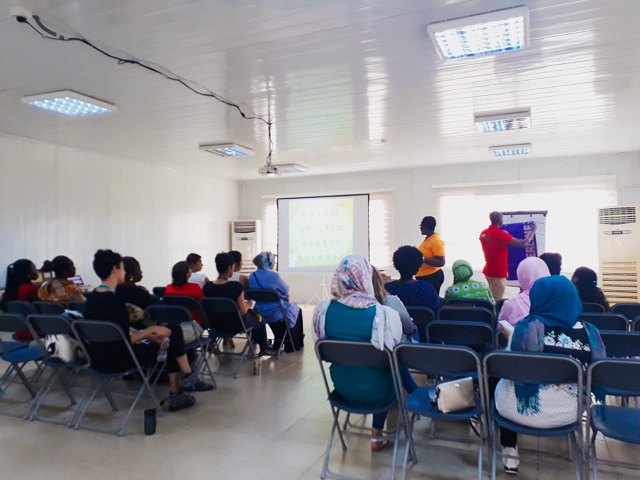
This morning at Primary held an Orientation session with Early Years Parents, specifically focused on Jolly Phonics.
What is Jolly Phonics? Specific to the English Language, Jolly Phonics is a child-centered approach to teach literacy, to Early Years children, through synthetic phonics. This gets children ready to read and write from an early age.
The Orientation was given by Roberta Emma Amos-Abanyie, the Director of the INGIT Jolly Phonics Foundation that provides Jolly Phonics and Grammar Training to Teachers and Parents. Although Early Years parents might be familiar with the basic gist of what their Children are learning in terms of Jolly Phonics, they were introduced to the main aspect of Jolly Phonics quite innovatively.
Ms. Roberta pulled up a slide with letters in characters of the Mandarin language and asked parents if they would be able to read that. Why not? Because it’s a different language they are not familiar with. Likewise, children of the early years have a different language of their own, and we as guardians and facilitators are introducing them to a completely new language and teaching them literacy, through Jolly Phonics!
The Jolly Phonics not only propels a greater understanding of the language but also is a tool to “Crack the Code” of the English Language. This is so that children are not only able to read and write and learn basic literacy but also be able to communicate independently.
There are 5 Basic Skills to grasp in Jolly Phonics –
1. Learning the Letter Sounds
2. Learning Letter Formation
3. Blending
4. Identifying Sounds in Words
5. Tricky Words
Reading storybooks to children, even from the time that they are in the womb is advisable to condition the child and give the example of good reading habits to the child. The ability to read stems from Jolly Phonics. The children learn sounds and are picking up on different sounds; Ms. Roberta said that at a minimum it takes up to 3 sounds to help children learn a complete word and be able to read it. The sounds, the combining of these sounds, putting them together and blending the said sounds is known as ‘Synthetic Phonics’.
Ms. Roberta demonstrated an example of Flashcards that are used in the classrooms, with sounds to show how sounds are taught and blended. Parents can also pick up on this and practice at home as well, as they reinforce reading habits.
Of course, any language is accompanied by common rules and exceptional rules. The exceptional rules apply to Tricky Words – especially with vowels – where the way they sound is different from how the words they are in are pronounced. This makes it an independent sound different from when it is blended, taking on a different sound. Thus, Ms. Roberta said that the ‘Tricky Words’ are taught through ‘Letter Names’, as opposed to ‘Sounds’ for the common rule of words. The Letter Sounds include –
1. s a t i p n
2. c/k e h r m d
3. g o u l f b
4. ai j oa ie ee or
5. z w ng v oo oo (short) oo(long)
6. y x ch sh th (voiced) th(voiceless)
7. qu ou oi ue er ar
With parents’ questions pertaining mainly to how parents can encourage children to read simple sentences, and gradually, read a children’s book, Ms. Roberta said that the process of Cracking the English Language Code is a gradual process. Thus, the preparation for Jolly Phonics at school and home is crucial to gradually increase students’ levels of reading.
Altogether, this Orientation/Workshop with the Early Years/Foundation parents was quite educational and helped them delve into the minds of how the youngest children in education learn!